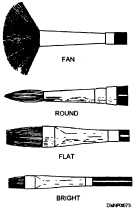Brushes, Continued
Brush bristles
Once collected and bound by hand, bristles were made from the hair of the
tail of a kolinsky . Bristles are now made from hog, sable, squirrel, ox, goat,
and camel hair, and synthetic materials such as nylon. Hog hair bristles are
often used for oil painting. Sables are most responsive when used with water
soluble pigments and ink washes. You can use sable brushes with oil and
acrylic pigments; but, the heavier bodied pigments inhibit the natural spring
in the brush. Squirrel, ox, and camel hair bristles and synthetic bristles are
suited to a variety of pigments. These bristles have less spring and stand up
well to paint and solvents. Oriental brushes used for calligraphic work and
sumi-e are made of goat hair.
Bristle length
The length of brush bristles affects how easily you can apply paint with a
brush. Short bristles tend to dig and shovel paint around the surface.
Bristles that are too short or that have been trimmed from longer bristles are
no longer good for painting. Long bristled brushes do not allow exact
placement of pigment to a surface because of the flexibility of the bristles.
Correct bristle length allows accurate placement and smooth covering of
pigments.
Brush shape
The four common brush shapes are the fan, round, flat, and bright.
Figure 1-16 shows the common shapes of paint brushes.
Figure 1-16.—Brush
shapes.
Continued on next page
1-27

